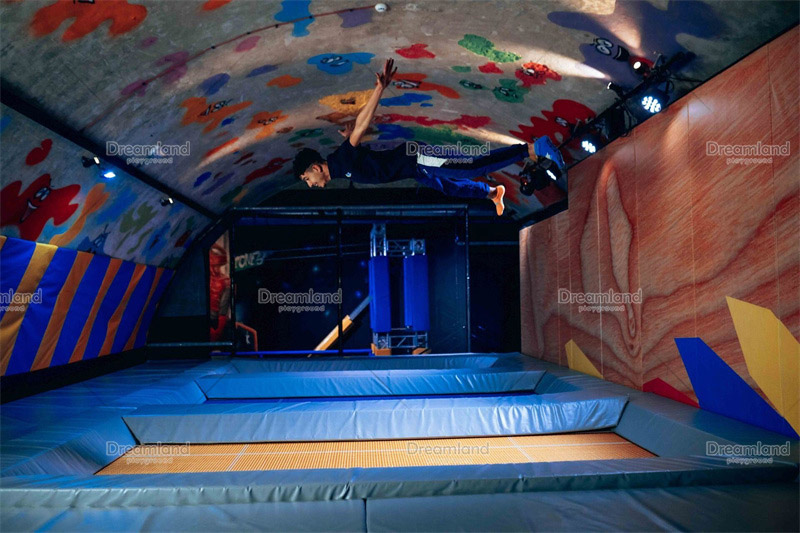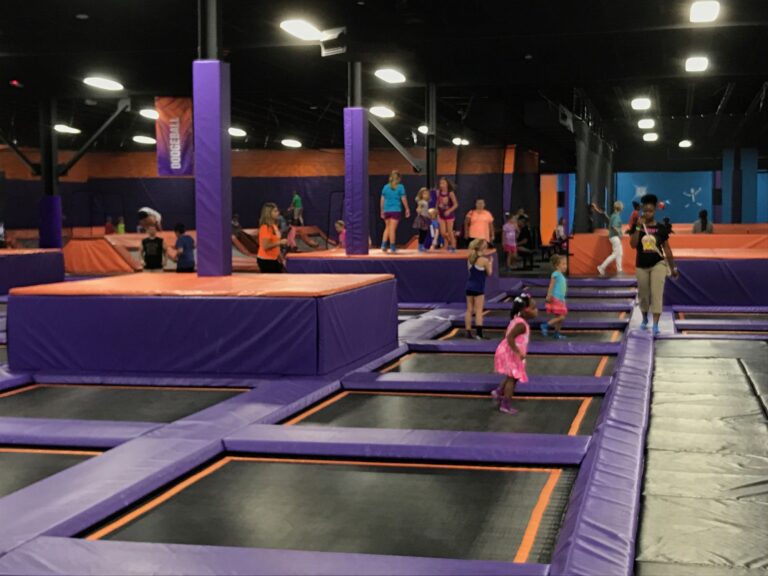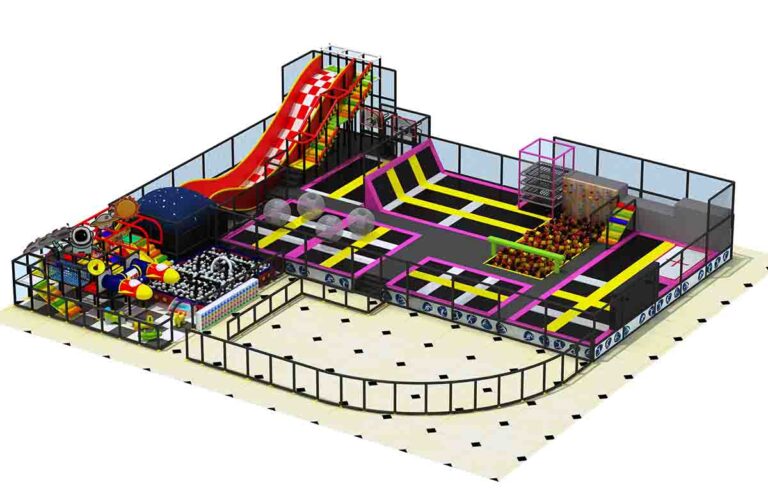Indoor Trampoline Parks vs. Outdoor Trampoline Parks: Pros and Cons
Cost
Initial Investment
The initial investment required for both indoor and outdoor trampoline parks can vary significantly. Indoor trampoline parks typically require a higher initial investment due to the costs associated with leasing or purchasing a suitable indoor space, as well as the construction and installation of the necessary infrastructure such as trampolines, safety nets, and padding. Additionally, indoor parks may require additional expenses for climate control systems and lighting. On the other hand, outdoor trampoline parks may have lower initial investment costs as they can utilize existing outdoor spaces, such as parks or open fields. However, outdoor parks may still require investments in durable and weather-resistant equipment, as well as fencing and landscaping to ensure safety and aesthetics. Ultimately, the decision between indoor and outdoor trampoline parks will depend on various factors such as location, target market, and available budget.
Maintenance Costs
Maintenance costs are an important consideration when comparing indoor trampoline parks to outdoor trampoline parks. Indoor trampoline parks generally require more regular and intensive maintenance due to the controlled environment and higher usage. The indoor facilities need to be regularly cleaned, sanitized, and inspected for any wear and tear. Additionally, the equipment and trampolines may require more frequent repairs or replacements due to the constant use. On the other hand, outdoor trampoline parks may have lower maintenance costs as they are exposed to natural elements and require less cleaning and sanitization. However, outdoor parks may face challenges such as weather damage, which can increase maintenance costs in the long run. Ultimately, the maintenance costs of indoor and outdoor trampoline parks will depend on various factors such as location, size, and the quality of equipment used.
Operating Costs
Operating Costs
When comparing indoor trampoline parks to outdoor trampoline parks, one crucial aspect to consider is the difference in operating costs. Indoor trampoline parks typically have higher operating costs due to various factors. Firstly, the cost of renting or owning a suitable indoor space is generally higher than an outdoor area. Additionally, indoor parks require constant temperature control and ventilation systems to ensure a comfortable environment for visitors, which adds to the electricity and maintenance expenses. Furthermore, indoor parks often need to invest in safety features such as padded flooring, safety nets, and foam pits, which can be costly to install and maintain. On the other hand, outdoor trampoline parks may have lower operating costs as they do not require the same level of infrastructure and ongoing maintenance. However, they may face challenges related to weather conditions and seasonal fluctuations in visitor numbers. Ultimately, the decision between an indoor or outdoor trampoline park should consider the long-term financial implications and the specific needs of the business.
Weather Dependence
Indoor Parks: No Weather Constraints
Indoor trampoline parks offer the advantage of no weather constraints, making them a popular choice for trampoline enthusiasts. Unlike outdoor parks, where activities can be affected by rain, wind, or extreme temperatures, indoor parks provide a controlled environment that allows visitors to enjoy trampolining regardless of the weather conditions outside. This means that individuals can bounce, flip, and jump to their heart’s content without worrying about rain ruining their plans or extreme heat making it uncomfortable to participate in the activities. Additionally, indoor parks often have climate control systems in place, ensuring a comfortable temperature for visitors throughout the year. Whether it’s a scorching summer day or a rainy winter afternoon, indoor trampoline parks offer a reliable and weather-resistant option for trampoline fun.
Outdoor Parks: Weather Limitations
Outdoor trampoline parks, despite their numerous advantages, are often limited by weather conditions. Unlike indoor parks, outdoor trampoline parks are subject to the whims of nature, making them susceptible to closures or reduced usage during inclement weather. Rain, snow, extreme heat, or strong winds can all pose safety risks and hinder the overall experience for visitors. Additionally, unpredictable weather patterns can make it challenging for outdoor parks to maintain a consistent schedule, potentially disappointing those who had planned to visit. However, when the weather is favorable, outdoor trampoline parks offer the unique opportunity to enjoy the thrill of bouncing while being surrounded by the beauty of nature.
Seasonal Considerations
Seasonal Considerations
When it comes to choosing between indoor and outdoor trampoline parks, seasonal considerations play a significant role. Outdoor trampoline parks are highly dependent on weather conditions, making them more suitable for regions with mild and consistent climates. In these areas, visitors can enjoy the fresh air and the feeling of being outdoors while bouncing on trampolines. However, during extreme weather conditions such as heavy rain, strong winds, or extreme heat, outdoor trampoline parks may have to close temporarily for safety reasons. On the other hand, indoor trampoline parks offer a year-round option for trampoline enthusiasts, regardless of the weather outside. They provide a controlled environment where visitors can enjoy trampolining without worrying about the impact of weather conditions. This makes indoor trampoline parks a more reliable choice for regions with unpredictable or harsh weather patterns. Additionally, indoor parks often have climate control systems, ensuring a comfortable experience for visitors regardless of the season.
Safety
Indoor Parks: Controlled Environment
Indoor trampoline parks offer a controlled environment for trampoline enthusiasts. One of the main advantages of indoor parks is that they provide a safe and secure space for people to enjoy trampolining. With a controlled environment, the risk of accidents and injuries is minimized as the park can regulate factors such as weather conditions and equipment maintenance. Additionally, indoor parks often have trained staff members who can supervise and guide participants, ensuring that everyone follows safety guidelines. This controlled environment allows individuals to have peace of mind while bouncing and trying out various trampoline activities, making indoor trampoline parks a popular choice for families and individuals seeking a safe and enjoyable trampolining experience.
Outdoor Parks: Natural Hazards
Outdoor trampoline parks, despite their exhilarating appeal, come with their fair share of natural hazards. One of the primary concerns is the unpredictable weather conditions. Unlike indoor parks, outdoor trampoline parks are exposed to the elements, making them susceptible to rain, wind, and extreme temperatures. Rain can create slippery surfaces, increasing the risk of accidents and injuries. Strong winds can also pose a danger, potentially causing trampolines to become unstable or even blow away. Additionally, extreme heat or cold can make trampolines uncomfortable to use and may affect the bounce quality. It is crucial for outdoor park operators to closely monitor weather forecasts and take necessary precautions to ensure the safety of their visitors.
Safety Measures
Safety Measures
Ensuring the safety of visitors is of utmost importance in both indoor and outdoor trampoline parks. To minimize the risk of accidents and injuries, various safety measures are implemented. In indoor trampoline parks, padded walls and floors are commonly used to provide a cushioned landing surface. Safety nets are also installed around the trampolines to prevent users from falling off. Additionally, trained staff members are present to enforce safety rules and guidelines, as well as to monitor the activities of the visitors. Outdoor trampoline parks, on the other hand, may have similar safety features such as safety nets and padded surfaces. However, they may also rely on natural surroundings like grass or sand to provide a softer landing. It is important for both types of trampoline parks to regularly inspect and maintain their equipment to ensure it is in good working condition. By implementing these safety measures, trampoline parks aim to create a secure and enjoyable environment for visitors of all ages.
Space and Capacity
Indoor Parks: Limited Space
Indoor trampoline parks offer the advantage of limited space, which can be seen as both a pro and a con. On one hand, the limited space in indoor parks allows for a more controlled and contained environment, ensuring the safety of participants. The confined space also means that the trampolines are closer together, creating a more interconnected and interactive experience for jumpers. However, the limited space can also be a drawback, as it may restrict the variety and size of trampolines and other attractions that can be installed. Additionally, during peak hours, the limited space may lead to overcrowding and longer wait times for participants. Overall, the limited space in indoor trampoline parks presents a trade-off between safety and the potential for a more diverse and spacious jumping experience.
Outdoor Parks: More Space
Outdoor trampoline parks offer the advantage of having more space compared to their indoor counterparts. With the freedom of the outdoors, these parks can accommodate larger trampolines and provide a greater area for jumping and performing tricks. The spaciousness allows for a more exhilarating experience, as there is ample room to bounce freely and explore different movements. Additionally, outdoor parks often have the advantage of being able to incorporate other outdoor activities, such as obstacle courses or water features, further enhancing the overall entertainment value. However, it is important to consider that outdoor parks are more susceptible to weather conditions, which can limit their availability during certain seasons or in unfavorable climates.
Capacity Constraints
Capacity constraints can be a significant factor when comparing indoor trampoline parks to outdoor trampoline parks. Indoor trampoline parks often have limited space due to being located within a building, which can result in a smaller overall capacity. This can lead to overcrowding during peak times, making it challenging for visitors to fully enjoy their experience. On the other hand, outdoor trampoline parks typically have more expansive areas, allowing for a larger number of visitors to participate simultaneously. This can alleviate capacity constraints and provide a more spacious and enjoyable environment for individuals to bounce and have fun. However, it is important to note that outdoor trampoline parks may be subject to weather conditions, which can impact their capacity and accessibility during certain seasons.
Accessibility
Indoor Parks: Urban Locations
Indoor trampoline parks, located in urban areas, offer a unique and convenient experience for trampoline enthusiasts. One of the major advantages of indoor parks is that they can operate year-round, regardless of weather conditions. This means that visitors can enjoy bouncing and performing tricks on trampolines even during rainy or cold seasons. Additionally, indoor parks often provide a controlled environment with climate control systems, ensuring a comfortable experience for visitors. The urban locations of these parks also make them easily accessible to a larger population, as they are usually situated in or near city centers. This accessibility allows people from all walks of life to easily visit and enjoy the trampoline park, making it a popular choice for families, friends, and even corporate team-building events.
Outdoor Parks: Rural Locations
Outdoor trampoline parks located in rural areas offer a unique and refreshing experience for visitors. One of the major advantages of these parks is the abundance of space available. Unlike their indoor counterparts, outdoor parks have the luxury of sprawling landscapes, allowing for larger trampoline setups and a greater variety of activities. Additionally, the natural surroundings of rural locations provide a picturesque backdrop, creating a more serene and peaceful atmosphere for visitors to enjoy. However, it is important to consider the potential drawbacks of outdoor parks in rural areas. Weather conditions can greatly impact the park’s operation, as rain or extreme temperatures may limit the park’s accessibility. Furthermore, the distance from urban areas might pose a challenge for some visitors, requiring longer travel times. Despite these factors, outdoor trampoline parks in rural locations offer a unique and exciting experience that cannot be replicated indoors.
Transportation Options
Transportation Options:
When it comes to visiting indoor trampoline parks versus outdoor trampoline parks, transportation options can play a significant role in deciding which option is more convenient. Indoor trampoline parks are often located in urban areas or shopping malls, making them easily accessible by public transportation or car. This means that visitors can rely on buses, trains, or taxis to reach their destination without the hassle of finding parking. On the other hand, outdoor trampoline parks are typically found in suburban or rural areas, which may require visitors to have their own means of transportation. While this allows for more flexibility in terms of timing and convenience, it can also be a drawback for those who do not own a car or prefer not to drive. Ultimately, the transportation options available for each type of trampoline park should be considered when deciding which one to visit.
Atmosphere and Experience
Indoor Parks: Controlled Environment
Indoor trampoline parks offer a controlled environment for trampoline enthusiasts. One of the main advantages of indoor parks is that they provide a safe and secure space for individuals to enjoy trampolining. With a controlled environment, the risk of accidents and injuries is significantly reduced as the park operators can regulate factors such as weather conditions and equipment maintenance. Additionally, indoor parks often have padded walls and floors, ensuring a softer landing surface and minimizing the impact on joints. The controlled environment of indoor trampoline parks allows individuals to have peace of mind while engaging in this exhilarating activity.
Outdoor Parks: Natural Surroundings
Outdoor trampoline parks offer the unique advantage of being set in natural surroundings. Unlike their indoor counterparts, outdoor parks allow visitors to enjoy the beauty of nature while bouncing and having fun. The lush greenery, fresh air, and open spaces create a refreshing and invigorating atmosphere for trampoline enthusiasts. Additionally, the natural surroundings provide a sense of freedom and connection to the outdoors, enhancing the overall experience. However, it is important to note that outdoor parks are more susceptible to weather conditions, which can sometimes limit their availability and usage.
Unique Experiences
Unique Experiences:
One of the key advantages of indoor trampoline parks is the ability to offer unique experiences regardless of the weather conditions. Unlike outdoor trampoline parks, which are subject to the whims of Mother Nature, indoor parks provide a controlled environment where visitors can enjoy trampolining activities all year round. Whether it’s scorching hot or pouring rain outside, indoor trampoline parks ensure that individuals can have a thrilling and safe experience without any interruptions. Additionally, these indoor facilities often incorporate various additional attractions such as foam pits, dodgeball courts, and obstacle courses, enhancing the overall experience and providing visitors with a wide range of activities to enjoy. The controlled environment and the availability of diverse attractions make indoor trampoline parks an excellent choice for individuals seeking a unique and enjoyable trampolining experience.






